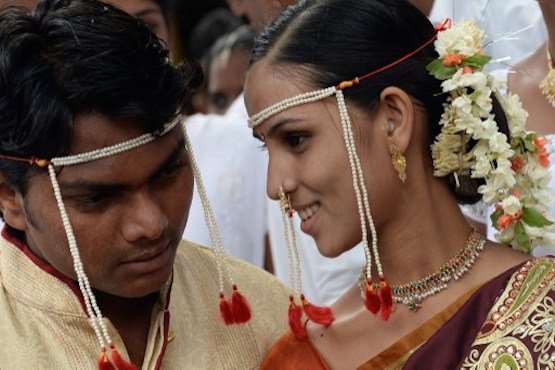Why Catholic marriage isn’t the same anymore
Why Catholic marriage isn’t the same anymore Paramount value in wedded bliss is no longer stability, but freedom.

An Indian groom listens to his bride as they arrive for their wedding in Mumbai in this file photo. (Photo by AFP)
One of the most pressing issues at last year’s synod on the family was the demand that re-married couples be admitted to the sacraments. It is an issue which provokes strong reactions either way.
Whatever the final decision forthcoming from the church, the reality is that more and more marriages are breaking up, and then reuniting 'in their own way — whether through a second civil marriage or through simple co-habitation. But there’s less guilt now, and many continue to seek Communion in the church they grew up in. Hence the petition to the synod.
This is one issue. The other is how to handle civil legislation, specially in the West, which increasingly recognizes same-sex unions as marriages. An aggressive secularist mentality refuses to see marriage as a religious bond at all, and considers gender identity as irrelevant to marriage.
Most Catholics have been brought up to consider marriage as an unchanging reality, something which most men and women enter into on attaining adulthood, which introduces them to family life and their place in society.
In this thinking, the underlying value was stability. A man and a woman entered this state by pre-arrangement, and were expected to live together until the death of one of the partners.
There were variables, of course, usually in favor of the man. A man might legally marry more than one woman; he might also enter into informal sexual relations with whichever other woman caught his fancy, and keep the relationship as long as he pleased.
In this, women were always at a disadvantage. Society generally looked askance at women who had more than one partner. And when married women became widows, they were expected to live as celibate recluses for the rest of their lives.
But marriage changed immensely in the latter part of the 20th century. Now its paramount value is no longer stability, but freedom; its purpose is no longer children but the mutual affective relationship of the partners.
Something else has also changed — women. With education, travel and better jobs, they are exercising their right to choose. They want to choose their partners, and even the right to move out of a defective marriage (unlike their mothers, who would have opted to endure it).
And if they do not find suitable spouses within their faith community, many women opt for partners from without. Inter-faith and inter-community marriages, are on the increase, much to the dismay of traditional leaders (in the church, yes), and in spite of so called 'honor killings' from men with patriarchal mindsets.
While women have changed, and are changing still, men are still stuck in a medieval rut. Male attitudes are still those of entitlement, control and violence, as the media keep reminding us with every newspaper headline.
With so many changes now in form as well as in values, how is the church preparing young people for marriage today?
In many places, the church insists on a 'pre-nuptial preparation course' for the prospective spouses, as a compulsory condition to having a 'church wedding.' But as often happens when something is made obligatory, the motivation to attend such courses is weak.
A better option seems to be the 'Engaged Encounter' (a parallel to the 'Marriage Encounter' program) where young couples intending to get married meet more frequently, with more time and opportunity to explore issues. What issues? Not only about sex, about which there is still so much misunderstanding, but specially about 'emotional connectivity,' the single most important reason for break-ups. And then, finances, a delicate but important issue.
As we know, attitudes to sex in India are still repressive. In recent times, addiction to pornography has emerged as an urgent pastoral problem, which pastors and counselors struggle to contain. But really: what alternative is there to porn in a culture which simply refuses to discuss sexual behavior among the young.
If young people can’t get their curiosity satisfied from parents and elders at home, they’ll get it on the street or from the web. Today, information is accessible everywhere.
There is a certain nostalgia in Catholic circles for an older time where marriage and family were stable and predictable. Those times have gone, fortunately. What is not said is that the stability of Catholic marriage was usually based on the oppression of women and the subjugation of children.
So how will Catholic spouses today face the challenges of their times? By conducting their lives in mutual fidelity, freedom, responsibility and respect for each other. There is no one successful formula, but there are as many options as there are creative opportunities.
Fr Myron J. Pereira SJ lives in Mumbai, where he is a writer. He can be reached at pereira.myron@yahoo.in, and at his website www.myronic.org.
- China's Communist Party to hold meeting on religion
- Lord's Prayer cinema ad ban in England
- The church in Vietnam keeps growing, but the obstacles persist.
- His predecessors and St Francis of Assisi show Pope Francis the way to China
- Archbishop Gomez: Religious freedom given by God, not government
- Measure of compromise
- In defence of the CofE’s House of Laity
- Evangelisation is not the work of specialists but of the entire people of God
- Religious freedom ‘under threat in US’
- Priests fear Egyptian youth will turn away from Church


 Votes : 0
Votes : 0









